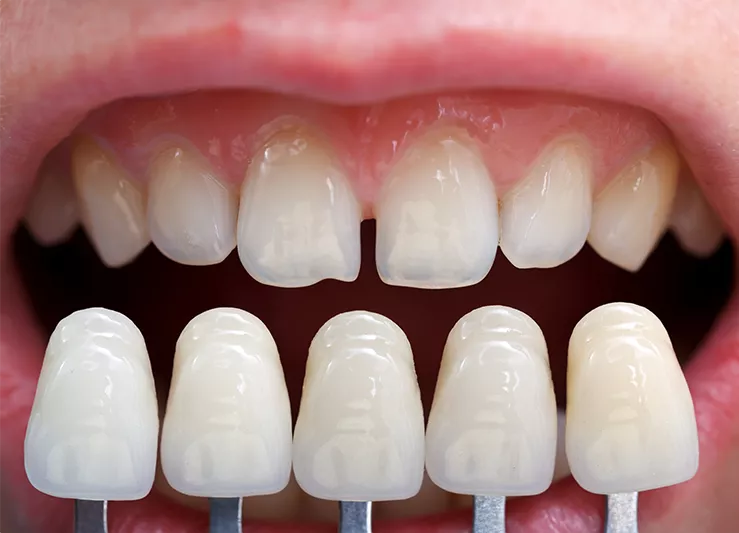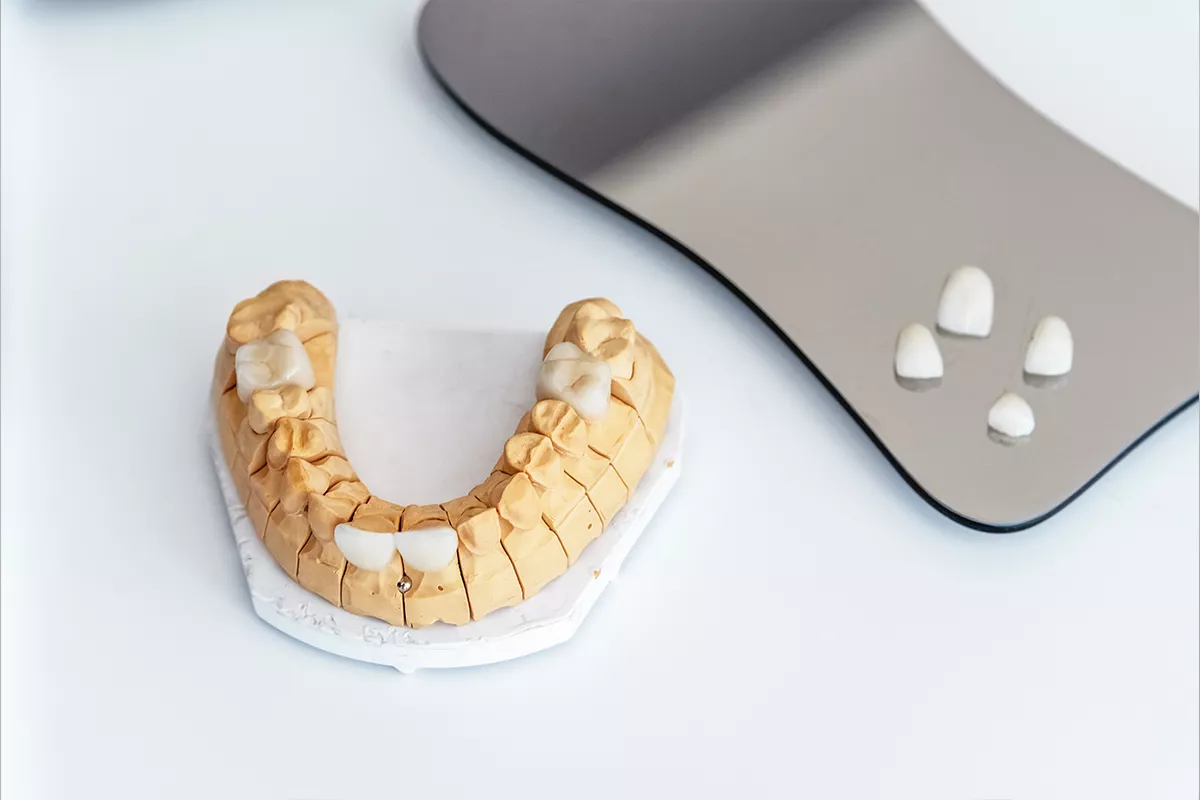Dental veneers are a popular and quick method to correct cosmetic problems such as stained teeth, chipped teeth, crooked teeth and gaps between teeth. Veneers are a cost-effective cosmetic treatment which have helped millions of people achieve their dream smile.
Dental veneers are irreversible and long-lasting, so it is important to understand how they work before beginning the treatment.
What are dental veneers?
Dental veneers are generally custom-made, thin coverings that are bonded to the front surface of a tooth to enhance their appearance. Veneers create the size, shape and colour of natural, aesthetically pleasing teeth, while taking into consideration the individual’s mouth and facial features. Once the customised shape of the dental veneers has been decided, the colour of the veneers will be selected to match the neighbouring teeth. The end goal is to create a natural-looking smile and to improve the patient’s confidence.
Composite vs Porcelain Veneers
There are two common types of dental veneers: composite resin veneers and porcelain/ceramic veneers.
Composite resin veneers are composed of a polymeric matrix and resin/glass filler particles that bond to your tooth. Resin is a very moldable material and hardens like ceramic when set. This material is strong and will not break or chip easily. Resin is a dental restoration material that can be blended to the colour of your teeth. Composite resin veneers are a fast and well accepted option because they require minimal tooth preparation and can be bonded immediately. In comparison to porcelain, composite resin can stain more easily from coffee, tea or smoking.
Porcelain veneers are more durable than composite veneers due to their density and strength. They are made of glass-like ceramic called feldspar; an extremely thin and translucent material. Porcelain veneers are widely accessible, resilient and resistant to staining, chipping, and discolouration. Today, most dental clinics are able to provide dental veneers in one or two dental visits, with the help of the advanced dental milling device, CEREC (Chairside Economical Restoration of Esthetic Ceramics). This non-invasive technology allows for designing and creating custom porcelain veneers in a single day, as well as providing a more comfortable experience for patients.
Typical dental problems that veneers can solve
Veneers are a fast and adequate solution for stained, chipped, misshapen or crooked teeth. In addition, dental veneers can also be used to close the gaps in your teeth where getting braces might not necessarily be the best option.
- Dark Teeth: Veneers can be used to fix a single discoloured tooth on the front due to trauma or root canal treatment.
- Chipped Teeth: Veneers conceal any damage done to your teeth and restore their appearance.
- Crooked Teeth: Veneers may be used to correct minor misalignment of teeth.
- Gaps in Teeth: Veneers can be used to close spaces between your teeth, caused by genetics or teeth shifting due to crowding.
- Worn Teeth: Veneers can be used to improve the appearance of damaged teeth when they have been worn down as a result of age or aggressive brushing of teeth.
Getting a teeth impression: The traditional method
A teeth impression is an imprint of your teeth used to create dental appliances. The traditional method of taking an impression involves the use of putty-like material that is moulded on your teeth. This method was more time-consuming and physically invasive than the new method that was introduced.
Getting a teeth impression: The advanced method
With advanced dental technology, patients can now get their veneer treatments with much greater accuracy and precision than ever before. The intraoral 3D scanner technology has replaced the traditional moulding method, which has brought along several benefits.With the new 3D scanner, dentists can capture a detailed image of your teeth and other facial features that are important to assess when designing new cosmetic teeth. When a digital model is created in the software, the treatment plan can be started. No moulds mean no risk of gagging, no environmental waste and an easier experience for patients.
What is the process for getting porcelain veneers?
- Oral examination – During the oral examination, your dentist will check for signs of gum disease and tooth decay, to make sure your teeth and jaws are in healthy condition. X-rays may be taken.
- Teeth cleaning – Your teeth will be thoroughly cleaned before the veneers are applied.
- Digital impression of teeth – An intraoral 3D scanner will be used to create a digital model of your teeth.
- Designing veneers – Your dentist will use a designing software to design custom-made dental veneers to fit your teeth.
- Preparation of teeth – The enamel on the front surface of your teeth will be adjusted to make room for the veneers.
- Creating veneers – The final design will be virtually sent to a milling machine for processing or may be hand crafted by a dental technician.
- Bonding veneers – The veneers will be fitted on your teeth and bonded in place with a dental adhesive.
- Post-operative care – Your dentist will give you specific instructions on how to take care of your teeth and gums after the procedure.

What are the benefits of getting dental veneers?
Here’s why you should consider veneers:
- Improved appearance of teeth – Dental veneers can fix various cosmetic problems, such as stained teeth, chipped teeth, crooked teeth, and gaps between teeth.
- Fast and easy treatment – Veneers can be placed in one dental visit.
- Custom-made – Veneers are custom-made based on the specific needs of each patient.
- Strong materials – Veneers are made of tough and durable materials. With proper care, veneers last for many years.
- Low maintenance – Veneers are easy to keep clean. They do not require any special treatment or intensive care. You can brush and floss your teeth as you normally would. It is important to keep in mind that the lifespan of veneers is affected by your dental habits.
What are the risks of getting dental veneers?
Dental veneers are an irreversible treatment that alter your natural teeth. You must consult your Dentist and have a clear understanding of your options before making a decision.
There are risks associated with getting dental veneers, but they are rare. The risks include:
- Shaping your teeth – To place the veneer, your dentist will need to remove a thin layer of enamel from your tooth. It can weaken your tooth and make it more susceptible to damage.
- Damage to teeth – If veneers are not set correctly, they can damage your teeth. Be sure to see a qualified and experienced dentist for your dental veneers.
- Allergy to materials – Some people may be allergic to the materials used to make veneers. Be sure to let your dentist know if you have any allergies.
- Pain and sensitivity – You may experience mild discomfort and sensitivity after getting veneers. This is usually temporary and in most cases, reduces with time.
Cost of dental veneers
The cost of dental veneers varies depending on many factors including the type of material required, the number you need, the shape of your existing teeth, the amount of staining present and the way your teeth meet together. They can vary from $450 to $1350 each. Have a chat to your cosmetic dentist to discuss which options are most suitable for you.
How long do dental veneers last?
Veneers are made of strong materials and are expected to last for many years with proper care. Their lifespan will depend on the type of veneer and your daily dental habits.
Composite resin veneers are considered to be weaker than ceramic veneers as they are a less dense material. Therefore, composite resins are indicated for mild to moderate dental changes while ceramics are better suited for major changes.
We advise discussing the risks and benefits of both types with your dentist as there is usually a material that is better suited for your situation as every patient is different. For example, as composites resins are minimally invasive to your enamel and can be completed in a number for hours, this may be more suitable for patients on a tight timeframe. It is difficult to directly compare the lifespan of dental veneers as they are used in different ways, however with good maintenance and care porcelain veneers usually last longer than composite resin veneers

How do I maintain my veneers?
After having your dental veneers placed, you will need to take care of them to prolong their lifespan. Here are some tips for taking care of your dental veneers:
- Brush your teeth twice a day with a soft-bristled toothbrush and non-abrasive toothpaste.
- Floss your teeth at least once a day.
- Use a mouth rinse to help remove plaque and bacteria from your mouth.
Avoid eating hard or sticky foods, which can damage your veneers.
- Avoid drinking coffee, tea, red wine, or other acidic drinks which can stain your veneers.
- If you grind your teeth at night, consult your dentist about getting a mouthguard.
- Avoid smoking, as this can stain your veneers.
- Visit your dentist for regular checkups and cleanings.
Are there any other options besides dental veneers?
If you are not happy with the idea of having dental veneers, or if your dentist does not offer them, other options are available. You could consider dental bonding, a treatment that uses composite resin to fill in small gaps and cracks in your teeth. Dental bonding is a quicker, less expensive, and less invasive treatment than veneers. However, it is not as durable nor long-lasting, and may need replacement after a few years.
A crown is a tooth-shaped cap that is placed over your tooth to cover it. It can be made from different materials, including porcelain, composite resin, or metal. Unlike veneers, dental crowns require more preparation of your tooth. Your dentist will need to remove more of your tooth enamel to place a crown.
Alternatively, you can consider getting dental braces. Braces can be used to straighten crooked teeth or to close small gaps between your teeth. They are more expensive and can take a longer period to fix a dental issue. You may also opt for clear aligners that are virtually invisible and more comfortable than metal braces.
Considering all of your options is essential. Your dentist will explain the different procedures and will recommend a suitable treatment for your needs.



